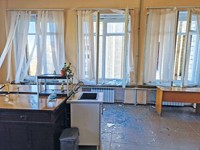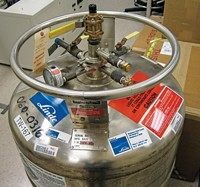Advertisement
Grab your lab coat. Let's get started
Welcome!
Welcome!
Create an account below to get 6 C&EN articles per month, receive newsletters and more - all free.
It seems this is your first time logging in online. Please enter the following information to continue.
As an ACS member you automatically get access to this site. All we need is few more details to create your reading experience.
Not you? Sign in with a different account.
Not you? Sign in with a different account.
ERROR 1
ERROR 1
ERROR 2
ERROR 2
ERROR 2
ERROR 2
ERROR 2
Password and Confirm password must match.
If you have an ACS member number, please enter it here so we can link this account to your membership. (optional)
ERROR 2
ACS values your privacy. By submitting your information, you are gaining access to C&EN and subscribing to our weekly newsletter. We use the information you provide to make your reading experience better, and we will never sell your data to third party members.
Research Funding
Europe’s energy crisis hits research infrastructure
Early shutdowns and supply chain issues disrupt science at Europe’s research facilities
by Laura Howes
December 21, 2022

Russia’s invasion of Ukraine continues to have wide-ranging impacts beyond the borders of the two countries. Energy prices have risen across Europe, caused in part by Russia reducing the amount of gas it delivers. In addition, supplies of materials, equipment, and isotopes have been disrupted. At large science facilities such as synchrotrons, staff are looking at their schedules and budgets and making choices that will have knock-on effects for researchers in 2023, and possibly beyond.
It is a crisis, says chemist Jana Kolar, chair of the European Strategy Forum on Research Infrastructures (ESFRI), which is tasked with supporting coherent policymaking regarding facilities, resources, and services used by researchers in Europe. She says that many facilities have “no way to cover their costs” without drastically changing their work schedules.
In Italy, the Elettra synchrotron and connected FERMI free-electron laser will stay shut in 2023 for much longer than initially planned, reducing user time by up to 50%. The SOLEIL synchrotron in France also will not restart for its first run in 2023, originally scheduled for Jan. 18 to Feb. 27. That represents around 5 weeks’ worth of lost beam time for users who already had experiments booked. SOLEIL Director General Jean Daillant says the decision was necessary. Without the shutdown and various additional measures, the synchrotron’s 2023 electricity bill would have increased by almost a factor of four. These facilities hope to be able to reschedule canceled experiments during later runs.
The other European synchrotrons still intending to operate have little to no spare capacity to absorb users from facilities that are shut down. DESY, the German Synchrotron Campus in Hamburg, receives up to three times as many applications for beamtime as they can provide for users, says Edgar Weckert, director in charge of photon science.
Weckert says DESY will keep running because the organization locked in the price for 80% of the synchrotron’s 2023 energy needs before costs spiked. Energy prices had been dropping towards the end of 2022, so DESY held out for as long as possible to try and get the best price for the final 20%. But the final price was three to four times more expensive per kilowatt hour than before, Weckert says. The organization hopes that the German government’s emergency funds for energy-intensive research will cover some of the overspending.
Reducing energy usage by switching off some electronics and turning down the heating where possible can also trim costs, but the overall savings are small. Weckert and Daillant estimate that these approaches can only save their facilities a few percent of the total energy used. Most of the energy used at these facilities is used to run incredibly precise pieces of equipment, which includes maintaining their temperatures and keeping some components near absolute zero.
The European X-Ray Free-Electron Laser (XFEL) is another facility that needs cryo-temperature cooling. It delivers ultrashort X-ray pulses for experiments to understand the structure of materials and biomolecules. While it is a separate facility and organization, the European XFEL purchases its energy supply in collaboration with DESY. Head of communications Bernd Ebeling says that, balancing increased costs with savings, the facility expects to pay around €1 million more for energy in 2023. That’s challenging, but the organization is confident it won’t have to make cuts into the user program, he says.
In addition to increased costs, facilities are also concerned about access to equipment and materials such as helium and nitrogen for cooling, Ebeling says. Neon, needed for laser experiments, is also in short supply because around 50% of the world’s market comes from Mariupol and Odessa in Ukraine, and cobalt-57, needed for Mössbauer spectroscopy, is presently only made in Russia.
To try and counter the shortages, researchers are taking new approaches. At SOLEIL, for example, an engineer has been working on ways to improve the recovery and recycling of helium. And several facilities are planning upgrades to make them more energy efficient in the longer term. The other elephant in the room is inflation, which soared into double digits in the Eurozone earlier this year and which experts forecast to stay elevated into 2023.
ESFRI is currently working on getting a full overview of the energy and supply chain issues faced by research infrastructures, from synchrotrons to supercomputers. But Kolar says it’s clear that they need more financial support from national governments to keep running. Cutting costs will quickly impact research and researchers, she says. Ultimately “it comes down to the cost and value of scientific discovery. We need to find solutions.”





Join the conversation
Contact the reporter
Submit a Letter to the Editor for publication
Engage with us on Twitter